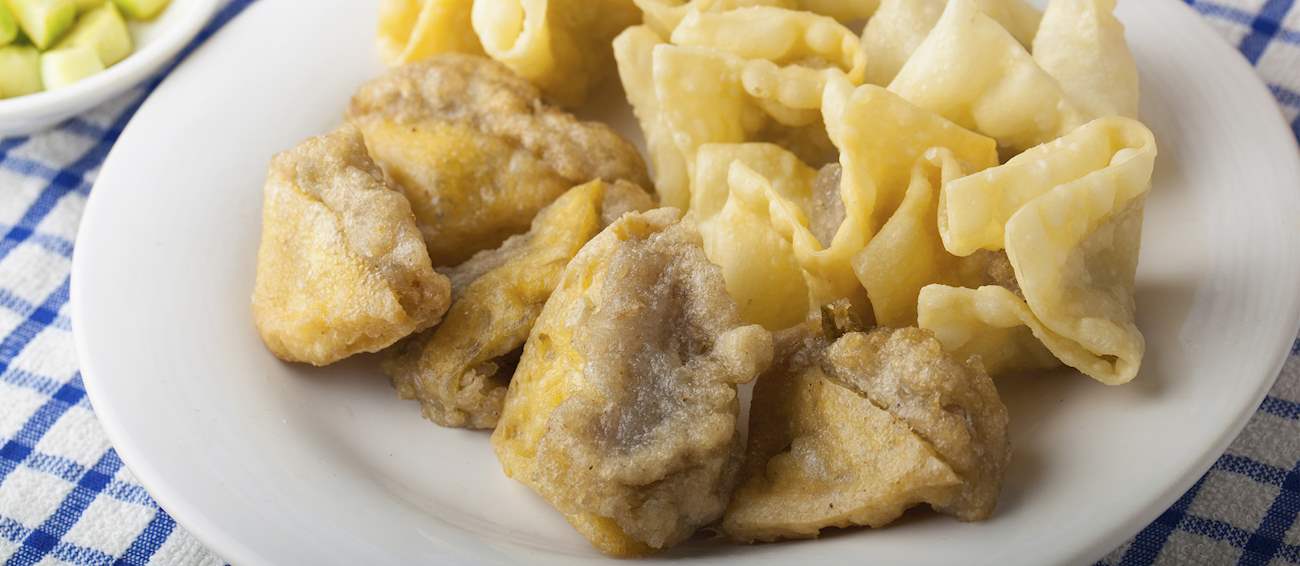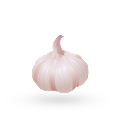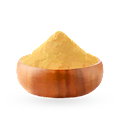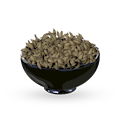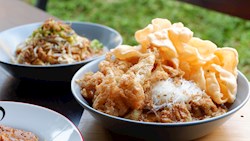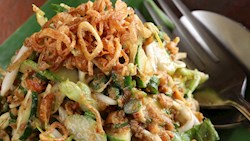TABLE OF CONTENTS
Best Javanese Foods
Soto Betawi is a hearty beef soup consisting of chunks of meat and offal that are slowly simmered in a coconut milk broth, which is usually enriched with various spices such as lemongrass, turmeric, galangal, kefir lime leaves, and coriander. When served, the soup is accompanied by different condiments that typically include tomatoes, scallions, sweet soy sauce, and emping crackers.
Because of its name, it is believed that the dish originated in Jakarta among the Betawi people, and today it is one of the most popular dishes in the city, usually sold at various street stalls, restaurants, or hawker-style establishments. Soto Betawi is traditionally enjoyed with steamed rice and pickled acar on the side.
OTHER VARIATIONS OF Soto
MOST ICONIC Soto Betawi
View moreOne of the most famous snacks in Indonesia is batagor, a fried fish dumpling served in a traditional spicy sauce. It has roots in the Chinese culinary tradition, which has left a trace on many Indonesian dishes. Although this famous snack is reminiscent of the more famous Chinese dumpling, its distinguishable characteristic is that it is fried, not steamed.
The most common fish used to make the dish is wahoo, but tuna, mackerel, and even prawns can also be used. Potatoes, tofu, or cabbage are also occasionally added to the dish. Batagor is the perfect snack because of the way it is served. When fried, the dumplings are cut into small bite-sized pieces and covered in peanut, soy, and chili sauce with a splash of lime juice.
MOST ICONIC Batagor
View moreMAIN INGREDIENTS
Sate Madura is a traditional dish and a type of sate originating from the island of Madura, hence the name. The dish is prepared with chicken or mutton pieces that are placed onto skewers and grilled. This type of sate is different from most other types since the meat is cut into thinner chunks than usual.
The skewers are accompanied by a dark sauce made with a combination of kecap manis (sweetened soy sauce), palm sugar, fried shallots, shrimp paste, peanut paste, candlenuts, salt, and garlic. If made with chicken, the dish is served in peanut sauce, while the mutton version often comes served in kecap manis.
OTHER VARIATIONS OF Satay
Rawon is a unique Indonesian dish with origins in East Java. This flavorful soup is usually made with slow-braised beef and other traditional Indonesian ingredients such as lime leaves, lemongrass, ginger, and chili. However, the key element is buah kluwek, the Indonesian black nut.
This unusual Indonesian spice is highly toxic when raw, and always needs to be fermented before consumption. It is ground with other ingredients and spices, giving the dish its earthy and sour taste and the unique dark black color. The origin of the dish is believed to be the city of Surabaya, the capital of East Java.
MOST ICONIC Rawon
View moreBubur ayam is the Indonesian version of chicken congee, a thick rice porridge topped with shredded chicken and various savory condiments. This breakfast staple probably originates from the Chinese rice porridge, but it employs regionally available ingredients and toppings to create an authentic Indonesian dish.
The process starts with boiling chicken (usually darker, on the bone pieces), and the same broth is typically used to cook the rice until it becomes dense in consistency. Besides rice porridge and shredded chicken, bubur ayam can employ a myriad of other ingredients.
MOST ICONIC Bubur ayam
View moreMAIN INGREDIENTS
Nasi uduk is one of numerous Indonesian rice-based dishes. The rice in nasi uduk is cooked in coconut milk together with lemongrass, cloves, pandan leaves, and cinnamon. The process results in wonderfully fluffy, fragrant rice, and right before it is served, each portion is usually topped with fried shallots.
It is a dish rarely eaten on its own, but rather served with a variety of side dishes and condiments. Most commonly a variety of stewed and fried meat, rice noodles, eggs, tempeh, tofu, fried anchovies, and rice crackers are served alongside rice.
Regular sambal, the spicy Indonesian hot sauce, or peanut sambal are the most common condiments served with nasi uduk.
MOST ICONIC Nasi uduk
View moreMAIN INGREDIENTS
This traditional Indonesian dish consists of rice cooked in coconut milk that is usually seasoned with turmeric, lemongrass, and kaffir lime leaves. Even though yellow rice is the star of nasi kuning, the dish is assembled out of other Indonesian dishes and complements, such as fried chicken, potato fritters, sliced omelet, fried anchovies, shrimps, or fried tempeh.
Sambal, the traditional Indonesian chili sauce, and serundeng (spicy fried coconut flakes) are often served as condiments. Nasi kuning is always served neatly organized on the plate, and the rice should always be placed in the middle. It is traditionally associated with the island of Java, which is considered to be the place of origin of this authentic Indonesian dish.
MOST ICONIC Nasi kuning
View moreMAIN INGREDIENTS
These Indonesian rice balls are prepared with glutinous rice flour shell that is wrapped around a palm sugar filling. The outer shell is usually colored green, traditionally with the help of pandan or dracaena leaves, while the whole cake is coated with desiccated coconut.
The origin of klepon is typically associated with Java, while the same treat is better known as onde-onde or buah melaka in some parts of Sulawesi, Sumatra, and Malaysia. It should be noted than on Java, the term onde-onde typically refers to Chinese jin deui rice balls.
MAIN INGREDIENTS
Tempeh mendoan is a variety of fried tempeh that hails from Purwokerto. Thin slices of tempeh—fermented soybean product—are dipped in batter that is enriched with ground coriander, sliced scallions, and garlic before they are deep-fried.
This tempeh variety is only shortly fried, creating a crispy outer layer, while the tempeh remains soft and juicy. The name of the dish stems from Banyumasan language in which mendo roughly translates as half-cooked. This tempeh is best served with sambal, other types of chili-based dips, or kecap manis—Indonesian sweet soy sauce.
MAIN INGREDIENTS
Sambal terasi is a traditional and Malaysian sauce and a variety of sambal. It's made with a combination of red chili peppers and shrimp paste (terasi) as the main ingredients. Various other ingredients are added to the sauce such as garlic, shallots, tomatoes, onions, lime juice, oil, sugar, and salt.
This fiery sauce is used as a condiment or an accompaniment to many dishes such as Malaysian lam mee noodles. In Malaysia, sambal terasi is known as sambal belacan.
Serve with
OTHER VARIATIONS OF Sambal
TABLE OF CONTENTS
Best Javanese Food Producers
AWARDS

EVO IOOC - Gold Medal
2016
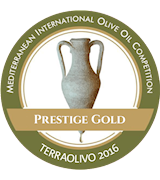
Terraolivo IOOC - Prestige Gold
2016, 2015
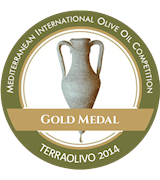
Terraolivo IOOC - Gold Medal
2014
BEST Altar Resources Olive Oils
Kopi Luwak is a renowned Indonesian coffee company specializing in the production of premium civet coffee, commonly known as Kopi Luwak. Established in 1969, the company has dedicated decades to perfecting the art of coffee cultivation and processing.
Their signature product is derived from coffee cherries consumed and naturally fermented by wild civets, resulting in beans that are meticulously collected, cleaned, roasted, and ground to produce a rich, full-bodied coffee with unique flavor notes of caramel and chocolate.
BEST Kopi Luwak Coffee Coffees
Indofood is one of Indonesia's largest and most prominent food companies, specializing in a wide range of products including instant noodles, snacks, dairy, beverages, and packaged foods. Established in 1968, it has become a household name, with its flagship product being the iconic Indomie instant noodles.
Indofood has a strong presence both in Indonesia and internationally, known for its high-quality food offerings and innovative production techniques.
BEST Indofood Condiments
Sedaap is a premium soy sauce brand crafted with care to deliver rich, authentic flavors. Known for its blend of quality ingredients and traditional Indonesian recipes, Sedaap is a versatile condiment perfect for enhancing a wide range of dishes. From stir-fries and marinades to dipping sauces, it brings a harmonious balance of sweetness and savory notes, making it a favorite choice for home cooks and culinary enthusiasts alike.
Discover the essence of true Indonesian taste with Sedaap.
BEST Sedaap Condiments
Bawang Goreng by R'A is a popular Indonesian snack made from crispy fried shallots. Known for its savory, slightly sweet flavor, this product is crafted from high-quality shallots that are thinly sliced and fried to perfection. Bawang Goreng by R'A is often used as a garnish or topping for various Indonesian dishes, such as nasi goreng (fried rice), soto (soup), or gado-gado (vegetable salad).
It adds a delicious crunch and rich flavor to any meal. The product is widely appreciated for its authentic taste and the premium quality of the shallots used.
BEST Bawang Goreng by R'A Condiments
UD Anugrah Jaya is an Indonesian company, typically involved in the production or distribution of food products, such as snacks, sauces, or seasonings. While the specific products and services may vary, companies with similar names often focus on high-quality food ingredients and local specialties that cater to both domestic and international markets.
UD Anugrah Jaya may operate in various sectors, including the food industry, by offering products that meet consumer demands for authentic flavors and traditional recipes.
BEST UD Anugrah Jaya Condiments
Bawang Goreng Wuenak is a delicious Indonesian snack made from crispy fried shallots. The shallots are thinly sliced and fried to a golden-brown crisp, creating a savory and slightly sweet flavor. Known for its crunchy texture and rich aroma, Bawang Goreng Wuenak is commonly used as a garnish for traditional Indonesian dishes like nasi goreng (fried rice), soto (soup), and gado-gado (vegetable salad).
Its authentic taste and high-quality ingredients make it a favorite snack and flavor enhancer in Indonesian cuisine.
BEST Bawang Goreng Wuenak Condiments
Mayta Jaya Mandiri is an Indonesian company engaged in the production and distribution of various food products. Specializing in traditional Indonesian snacks and ingredients, the company is known for offering high-quality products such as fried shallots, spices, and other culinary essentials.
Mayta Jaya Mandiri focuses on providing authentic flavors, aiming to deliver a premium experience of Indonesian cuisine to its customers. With a commitment to quality and excellence, the company has become a trusted name in the food industry.
BEST Mayta Jaya Mandiri Herbs and Spices
Argo Pandan Wangi is a premier Indonesian company specializing in the production and export of high-quality dried galangal. Their flagship product is meticulously harvested and processed to preserve its distinctive flavor and aroma, ensuring an unparalleled culinary experience.
The company is committed to sustainable farming practices and supports local farmers, reflecting their dedication to social responsibility. By choosing Argo Pandan Wangi, customers receive top-quality galangal while contributing to the well-being of local communities and the environment.
BEST Argo Pandan Wangi Herbs and Spices
TABLE OF CONTENTS
Best Javanese Food Products
The product Quinta de Sao Miguel Do Seixo Early Harvest Evoo Gourmet made by Altar Resources S. A. is an olive oil that is noted for its high quality and distinctive flavor profile. It is produced from olives that are harvested early in the season, which contributes to its robust and fresh taste.
This extra virgin olive oil is known for its vibrant green color and fruity aroma, with hints of grass and green apple, indicating a high level of antioxidants. This gourmet olive oil is typically used by chefs and food enthusiasts to enhance the flavor of various dishes, from salads to grilled meats.
AWARDS

Terraolivo IOOC - Prestige Gold
2016, 2015

Terraolivo IOOC - Gold Medal
2014
Quinta De São Miguel Do Seixo Early Harvest EVOO is produced by Altar Resources S. A., an entity known for producing high-quality olive oil. This extra virgin olive oil (EVOO) is distinguished by its early harvest, which typically means that the olives are picked at their peak of freshness, often resulting in a more robust and pungent flavor profile compared to later harvests.
Early harvest oils are usually higher in antioxidants and have a distinctive, vibrant green color. This particular EVOO is crafted to preserve the natural qualities of the olives, making it an excellent choice for health-conscious consumers and culinary enthusiasts who appreciate premium-grade olive oil.
AWARDS

EVO IOOC - Gold Medal
2016
AWARDS

The Rum & Cachaça Masters - Gold
2023
Kecap Manis Indofood is a sweet soy sauce that is a staple in Indonesian cuisine. Known for its rich, dark color and syrupy consistency, it combines soy sauce with palm sugar, garlic, and various spices, creating a distinctively sweet and savory flavor.
Kecap Manis is commonly used in marinades, stir-fries, grilled meats, and as a condiment for rice dishes, adding depth and umami to many traditional Indonesian dishes. Indofood’s version is a popular choice for home cooking and is widely recognized for its quality and consistent taste.
Kecap Manis Sedaap is a popular Indonesian sweet soy sauce known for its rich, thick texture and balanced flavor profile. Made from high-quality soybeans, sugar, and a variety of natural spices, it offers a unique combination of sweetness and umami.
Kecap Manis Sedaap is widely used in Indonesian cooking, particularly in dishes like nasi goreng (fried rice), mie goreng (fried noodles), and satay. It can also be used as a marinade, dipping sauce, or a flavorful addition to stir-fries, enhancing the taste of any dish.
Its deep, aromatic taste makes it a beloved condiment both in Indonesia and globally.
Bawang Goreng by R'A is a premium Indonesian product made from crispy fried shallots. This snack is carefully crafted by frying thinly sliced shallots to a golden, crunchy perfection. Known for its savory and slightly sweet flavor, Bawang Goreng by R'A is a versatile ingredient commonly used in Indonesian cuisine.
It is often sprinkled on top of various dishes like nasi goreng (fried rice), soto (soup), gado-gado (vegetable salad), and more, to add texture and enhance flavor. The product is appreciated for its authenticity and high quality, making it a popular choice for both local and international consumers.
Bawang Goreng by UD Anugrah Jaya is a premium Indonesian snack made from crispy fried shallots. Carefully prepared by thinly slicing shallots and frying them to golden perfection, this product offers a deliciously savory and slightly sweet flavor.
It is commonly used as a topping or garnish for various Indonesian dishes, such as nasi goreng (fried rice), soto (soup), and gado-gado (vegetable salad). With its crunchy texture and rich taste, Bawang Goreng adds an authentic flavor to meals, making it a favorite among food enthusiasts.
Wuenak Premium Fried Shallots are high-quality, crispy fried shallots that add a delicious savory and slightly sweet flavor to various dishes. Thinly sliced and fried to a golden-brown crisp, these shallots are commonly used as a garnish or topping for traditional Indonesian meals like nasi goreng (fried rice), soto (soup), and gado-gado (vegetable salad).
Known for their crunchy texture and rich taste, Wuenak Premium Fried Shallots bring an authentic touch to your meals, enhancing both flavor and presentation.
Galangal - Mayta Jaya Mandiri is a high-quality, fresh galangal root used in traditional Indonesian cooking. Known for its distinctive, aromatic flavor with a combination of citrusy and spicy notes, galangal is an essential ingredient in many Southeast Asian dishes such as soto (soup), rendang (beef curry), and tom yum (spicy soup).
The fresh galangal root from Mayta Jaya Mandiri is carefully selected for its freshness and flavor, making it a perfect addition to enhance the depth and authenticity of your culinary creations.
Dried Galangal is a premium product offered by Argo Pandan Wangi, meticulously harvested and processed to preserve its distinctive flavor and aroma. This dried rhizome is a staple in Southeast Asian cuisine, imparting a unique, spicy, and slightly citrusy note to dishes.
Beyond its culinary applications, galangal has been used for centuries in traditional medicine due to its anti-inflammatory, antioxidant, and antimicrobial properties. It aids digestion, alleviates nausea, and supports overall health. Argo Pandan Wangi ensures that their dried galangal meets the highest quality standards, making it an excellent choice for both culinary and medicinal purposes.
TasteAtlas food rankings are based on the ratings of the TasteAtlas audience, with a series of mechanisms that recognize real users and that ignore bot, nationalist or local patriotic ratings, and give additional value to the ratings of users that the system recognizes as knowledgeable. For the “Top 70 Javanese Foods” list until March 27, 2025, 3,008 ratings were recorded, of which 1,972 were recognized by the system as legitimate. TasteAtlas Rankings should not be seen as the final global conclusion about food. Their purpose is to promote excellent local foods, instill pride in traditional dishes, and arouse curiosity about dishes you haven’t tried.
